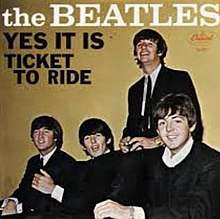Yes It Is
"Yes It Is" is a song by the English rock band the Beatles. Written by John Lennon (credited to Lennon–McCartney) it was first released in 1965 as the B-side to "Ticket to Ride". It features some of the Beatles' most complex and dissonant three-part vocal harmonies and showcases George Harrison's early use of volume pedal guitar. Ian MacDonald describes the song as having "rich and unusual harmonic motion."[2]
| "Yes It Is" | ||||
|---|---|---|---|---|
 US picture sleeve | ||||
| Single by the Beatles | ||||
| A-side | "Ticket to Ride" | |||
| Released | 9 April 1965 | |||
| Recorded | 16 February 1965 | |||
| Studio | EMI, London | |||
| Genre | Pop[1] | |||
| Length | 2:41 | |||
| Label | Parlophone | |||
| Songwriter(s) | Lennon–McCartney | |||
| Producer(s) | George Martin | |||
| The Beatles UK singles chronology | ||||
| ||||
| The Beatles US singles chronology | ||||
| ||||
Composition
In his 1980 interview with Playboy, John Lennon described "Yes It Is" as an attempt to rewrite "This Boy" (the style of the song) that "didn't quite work".[3] Paul McCartney on the other hand described it as "a very fine song of John's" that he and Lennon had finished writing together.[4]
Musical structure
The song is in the 12/8 time signature, in the key of E and begins (on "If you wear red tonight ...") with a I–IV–ii7–V7 chord progression (E–A–F#m7–B7) in which the word "tonight" (B melody note) appears as a "delicately haunting" 4th above the F#m7,[5] creating a suspension. The melodic pitches of this first two bar phrase are repeated (with initial repetition of the G# melody note) on "remember what I said tonight," except that the B melody note on the second "tonight" is now backed by a ♭VII (D) chord that shapes the B melody note into a more "luscious" 6th.[5] The chorus ("Yes it is, it's true. Yes it is, it's true") involves a I (E chord) – III (G# chord) – IV (A chord) – I (E chord) progression in which the major III (G#) chord appears for the first time in the song to propel the Plagal drop from IV (A) to the tonic I (E) chord.[6]
Recording
Over the course of a five-hour recording session, the Beatles attempted 14 takes of the basic track before perfecting it.[7] "Yes It Is" was recorded on 16 February 1965, the same day that they completed Harrison's "I Need You".[7] After completing the rhythm track, Lennon, McCartney and Harrison recorded their vocal harmonies in three hours, singing live together using the suggestion of George Martin that they sing their three part harmony in the style of a barber shop quartet.[7]
Release and reception
"Yes It Is" was released as the B-side of the "Ticket to Ride" single in both the US and the UK.[8] American pressings of the single erroneously show "Yes It Is" as being from the film Eight Arms to Hold You (the original title for the film, Help!),[9] in which it did not appear.[10] It reached number 46 in the Billboard Hot 100.
The song was included on Beatles VI in the US (utilizing the "duophonic" stereo remix from the original mono track, with additional echo and reverb added), and on subsequent compilation albums including Love Songs, the British version of the Rarities album, Only the Beatles, a British promotional cassette for Heineken Beer in 1986 (on which it made its first true stereo appearance), Past Masters, Volume One, and also on Anthology 2 in an alternate version that combines the second and fourteenth takes. The original mono single mix appears on the Mono Masters CD as part of The Beatles in Mono box set.
Author Ian MacDonald praised "Yes It Is" along with its accompanying a-side "Ticket to Ride". He described the both songs as "psychologically deeper than The Beatles had ever recorded before" and declared that they marked a huge step forward in the Beatles development as songwriters.[11]
Personnel
According to Ian MacDonald:[12]
- John Lennon – double-tracked lead vocal, semi-acoustic guitar
- Paul McCartney – harmony vocal, bass guitar
- George Harrison – harmony vocal, lead guitar
- Ringo Starr – drums, tambourine
Notes
- "The Beatles 'Yes It Is'". AllMusic. Retrieved 23 November 2014.
- MacDonald 2005, p. 147).
- Sheff 2000, p. 196.
- Beatles Interview Database 2009.
- Pedler 2003, p. 721.
- Pedler 2003, pp. 112–113.
- Lewisohn 1988, p. 54.
- Lewisohn 1988, p. 200.
- Harry 2000, p. 1074.
- Harry 2000, p. 504.
- MacDonald 2005.
- MacDonald 2005, p. 146.
References
- "Help". Beatles Interview Database. 2009. Retrieved 23 September 2009.
- Harry, Bill (2000). The Beatles Encyclopedia: Revised and Updated. London: Virgin Publishing. ISBN 0-7535-0481-2.CS1 maint: ref=harv (link)
- Lewisohn, Mark (1988). The Beatles Recording Sessions. New York: Harmony Books. ISBN 0-517-57066-1.CS1 maint: ref=harv (link)
- MacDonald, Ian (2005). Revolution in the Head: The Beatles' Records and the Sixties (Second Revised ed.). London: Pimlico (Rand). ISBN 1-84413-828-3.CS1 maint: ref=harv (link)
- Pedler, Dominic (2003). The Songwriting Secrets of the Beatles. New York City: Omnibus Press.CS1 maint: ref=harv (link)
- Sheff, David (2000). All We Are Saying: The Last Major Interview with John Lennon and Yoko Ono. New York: St. Martin's Press. ISBN 0-312-25464-4.CS1 maint: ref=harv (link)